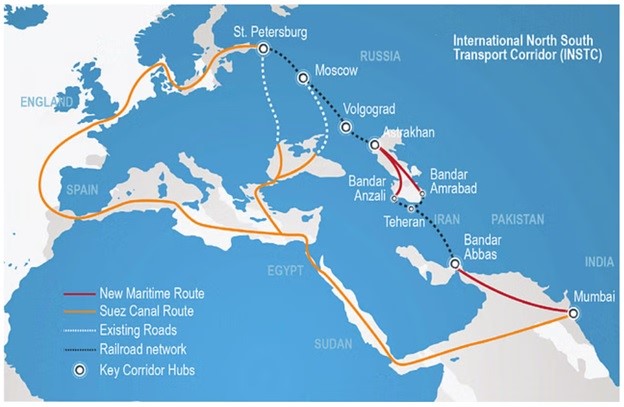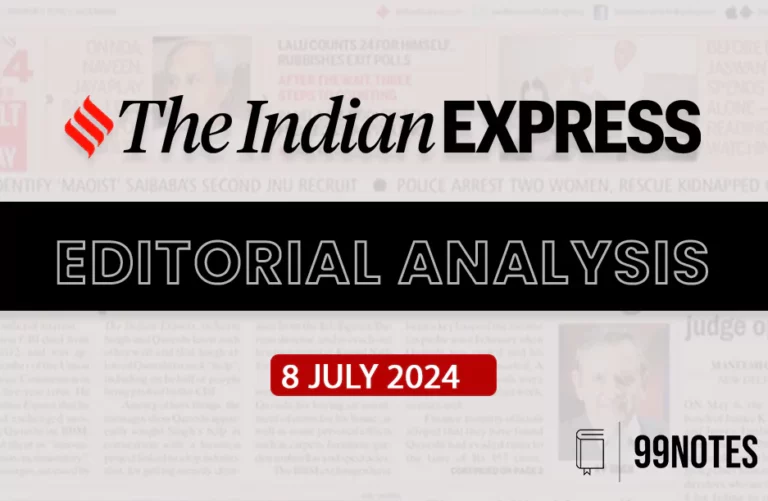15 July 2024 : Indian Express Editorial Analysis
1. PICTURED WITH DIGNITY
(Source: Indian Express; Section: The Editorial Page; Page: 10)
| Topic: GS2– Social Justice |
| Context: |
|
Rights of Persons with Disabilities Act, 2016
- The Act was passed by the Parliament of India to give effect to the United Nations Convention on the Rights of Persons with Disabilities (UNCRPD), which India ratified in 2007.
- The Act replaces the earlier Persons with Disabilities (Equal Opportunities, Protection of Rights and Full Participation) Act, 1995, which was considered inadequate and outdated in addressing the needs and challenges of persons with disabilities in India.
- One of the major changes introduced by the Act is the expansion of the definition and classification of disabilities.
- The Act recognises 21 types of disabilities, as compared to 7 types under the previous law. These are:
- Blindness, Low-vision, Leprosy cured persons,
- Hearing impairment (deaf and hard of hearing), Locomotor disability, Dwarfism,
- Intellectual disability, Mental illness, Autism spectrum disorder,
- Cerebral palsy, Muscular dystrophy, Chronic neurological conditions,
- Specific learning disabilities, Multiple sclerosis, Speech and language disability,
- Thalassemia, Hemophilia, Sickle cell disease,
- Multiple disabilities including deafblindness, Acid attack victim, and Parkinson’s disease.
- It empowers the central government to notify any other category of specified disability.
- It defines a person with a disability as a person with a long-term physical, mental, intellectual or sensory impairment which, in interaction with barriers, hinders his full and effective participation in society equally with others.
- It defines a person with benchmark disability as a person with not less than 40% of a specified disability where a specified disability has not been defined in measurable terms and includes a person with a disability where a specified disability has been defined in measurable terms, as certified by the certifying authority.
- It recognises persons with disabilities have high support needs and need intensive support from others for their daily activities.
Emphasis on the Human Rights Model of Disability
- The Supreme Court emphasized the human rights model of disability, which extends beyond the social and medical models.
- The medical model views disability as a medical condition within an individual, whereas the social model attributes disability to societal attitudes and structures.
- The human rights model, embedded in international human rights law principles, asserts that disability is a natural part of human diversity, and PwDs are rights holders whose participation and inclusion in society must be ensured.
- This emphasis is significant as it places a positive obligation on governments and private parties to facilitate effective participation.
Obligations Under the RPwD Act
- The extent of the obligation of private bodies under the RPwD Act is a contentious issue.
- In the case of Vikash Kumar vs. UPSC, the Supreme Court accepted the obligation of private parties under the RPwD Act and acknowledged the limitation of this obligation.
- The Court denied the applicant’s request to compel Sony Pictures to make awareness films under section 7(1)(d), citing that this would amount to “compelled speech.”
- However, the Court provided detailed jurisprudence on the “attitudinal barrier” recognized under the social model of disability.
Addressing Stereotypes and Attitudinal Barriers
- The Supreme Court acknowledged that stereotypes play an instrumental role in perpetuating the attitudinal barrier against PwDs.
- It emphasized that stereotypes operationalize discrimination and are antithetical to dignity and non-discrimination.
- Stereotypes undermine the dignity of individuals, protected under Article 21, by causing systematic and hidden exclusion.
- The Court differentiated between cinematic speech, hate speech, and group defamation laws, highlighting the need for context in evaluating speech targeting marginalized communities.
Context of Speech Analysis
- The Supreme Court employed a “context of speech” analysis, emphasizing that derogatory speech often targets marginalized communities.
- Factors such as the impact on human dignity, the identity of the speaker, the target, and the linguistic connotation of the speech are crucial.
- These aspects operate within the reasonable restriction imposed on freedom of speech under Article 19(2).
- The Court reiterated that expressions targeting marginalized groups and strengthening prejudices are not protected under Article 19(1)(a).
Guidelines for Sensitive Representation
- The Supreme Court concluded that creative freedom in filmmaking does not include the freedom to lampoon, stereotype, misrepresent, or disparage marginalized groups.
- The intention and overall message of the film must be considered. The Court’s nine-point guidelines cover aspects from language usage to consultation with disability advocacy groups.
- This framework calls for a nuanced portrayal of disability in visual media, as seen in the recent film Srikanth. The effectiveness of these guidelines will be evaluated in the coming years.
Conclusion
- The Supreme Court’s framework is a timely intervention, highlighting the need for a more sensitive understanding of disability in visual media.
- It underscores the importance of respecting the dignity and rights of PwDs, ensuring their fair and accurate representation in films and other media.
| Accessible India Campaign (AIC) |
|
| Practice Question: Discuss the significance of the Supreme Court’s recent framework on the representation of Persons with Disabilities (PwDs) in visual media. How does this framework align with the human rights model of disability, and what are its implications for social justice and inclusion in India? (250 words/15 m) |
2. India’s Moscow connection
(Source: Indian Express; Section: The Ideas Page; Page: 11)
| Topic: GS2 – International Relations – Bilateral Relations |
| Context: |
|
Diplomatic and Symbolic Importance
- Modi’s visit is particularly significant as few global leaders of his stature, except Chinese President Xi Jinping, have visited Moscow in the last two years.
- By choosing Russia as his first foreign destination for a bilateral meeting in his third term, PM Modi sends a powerful message.
- In a time when Russia faces Western isolation, such visits help the Kremlin counter the narrative of its global isolation.
- India’s continued sympathy towards Russia, seen in its refusal to condemn Russia, refrain from adverse UN votes, and ignore Western threats of sanctions, further solidifies this relationship.
Economic and Trade Relations
- India’s trade with Russia reached a historic high of $65 billion in the last financial year, driven by India’s import of cheap oil from Russia.
- Despite severe criticism, India justified these imports by emphasizing their role in keeping energy prices and inflation under control.
- However, the prolonged conflict poses challenges for Indian policymakers. India’s diplomacy is strained between Western criticism, inflationary pressures, and Russia’s growing closeness to China.
Concerns Over Russia-China Relations
- Russia’s growing dependence on China is a serious concern for India.
- The close ties between Moscow and Beijing generate fears that Russia might become a subordinate partner due to the economic, demographic, and technological asymmetry between them.
- India’s strong ties with Russia aim to counterbalance China’s advantage in Eurasia.
- With the US and Japan on its side and Russia as a neutral player, India is better positioned than China in the Asian security architecture.
- Moscow acknowledges New Delhi’s concerns and accepts India’s ties with the West, similar to how India accepts the Moscow-Beijing alignment.
Substantive Agreements and Existing Ties
- While the visit may not result in spectacular substantive agreements, it adds momentum to the already comprehensive India-Russia relationship.
- The two countries cooperate across various sectors, including defense, trade, space, nuclear, and cultural cooperation, and collaborate actively in multilateral forums like BRICS, SCO, and G20.
- The focus should be on revamping existing ties rather than adding new items to the catalogue.
Addressing Trade Imbalance and Defense Commitments
- A significant issue for New Delhi is the trade imbalance, with India’s exports constituting less than $5 billion of the total $65 billion trade.
- This imbalance is unsustainable in the long run, and Russia needs to scale up its purchases from and investment in India.
- Exploring new areas of joint production can help ease the burden on India.
- Additionally, India is concerned about whether Russia can fulfill its defense commitments, given Western sanctions on the supply of semiconductor chips.
- Timely delivery of defense spare parts and S-400 systems would alleviate India’s concerns.
International North-South Transport Corridor and Economic Cooperation
- Russia must invest more diplomatic and financial resources to complete the pending works for the International North-South Transport Corridor.
- Recently, Russia supplied coking coal to India through this route, indicating progress.
- Both sides should expedite discussions on the Free Trade Agreement with the Eurasian Union to enhance economic cooperation.
What is the International North-South Transport Corridor (INSTC)?

- INSTC is a 7,200-kilometer Multimode Transit Route linking the Indian Ocean and the Persian Gulf to the Caspian Sea via Iran and onward to northern Europe via St. Petersburg in Russia.
- It connects ship, rail, and road routes for moving cargo between India, Iran, Azerbaijan, Russia, Central Asia, and Europe.
Origin:
- It was launched on 12th September 2000 in St. Petersburg, by a trilateral agreement signed by Iran, Russia and India at the Euro-Asian Conference on Transport in 2000 for promoting transportation cooperation among the Member States.
Ratification:
- Since then, INSTC membership has expanded to include 10 more countries (total 13)-Azerbaijan, Armenia, Kazakhstan, Kyrgyzstan, Tajikistan, Turkey, Ukraine, Syria, Belarus, and Oman.
Routes and Modes:
- Central Corridor: It begins from the Jawaharlal Nehru Port in Mumbai and connects to the Bandar Abbas port (Iran) on the Strait of Hormuz. It then passes through the Iranian territory via Nowshahr, Amirabad, and Bandar-e-Anzali, runs along the Caspian Sea to reach the Olya and Astrakhan Ports in Russia.
- Western Corridor: It connects the railway network of Azerbaijan to that of Iran via the cross-border nodal points of Astara (Azerbaijan) and Astara (Iran) and further to Jawaharlal Nehru port in India via sea route.
- Eastern Corridor: It connects Russia to India through the Central Asian countries of Kazakhstan, Uzbekistan, and Turkmenistan.
Strategic Implications and Global Message
- The visuals of Modi-Putin’s embrace send an unequivocal message to the international community that Russia holds a pivotal place in India’s strategic calculations, and India will not yield to external pressures.
- New Delhi is willing to withstand Western criticism, but any escalation to sanctions and strategic alienation could change its priorities. It appears assured that the West needs India as much as India needs the West.
- Notably, PM Modi’s meeting with Putin coincides with NATO’s 75th anniversary celebrations in Washington, DC, highlighting the intricate geopolitical dynamics at play.
|
PYQ: What is the importance of developing Chabahar Port by India? (2017) (a) India’s trade with African countries will enormously increase. (b) India’s relations with oil-producing Arab countries will be strengthened. (c) India will not depend on Pakistan for access to Afghanistan and Central Asia. (d) Pakistan will facilitate and protect the installation of a gas pipeline between Iraq and India. Ans: (c) |
| Practice Question: Discuss the strategic significance of Prime Minister Narendra Modi’s visit to Moscow in the context of India’s foreign policy. How does this visit aim to balance India’s relationships with Russia and the Western nations, particularly in light of the ongoing Ukraine conflict and Russia’s growing dependence on China? (250 words/15 m) |





